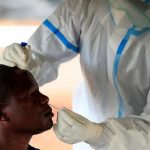The weekly rates of new hospitalisations have been significantly high for the past three weeks (120%; 166%; and 125%). But this was still lower compared to previous periods in which infection numbers rose. Also, the current increase came off a very low base as admission numbers had fallen after the last COVID-19 waves in Gauteng.
Another caveat, is that some patients have been admitted for other conditions, and were diagnosed with COVID-19 due to routine testing protocols in hospital, and not because they showed symptoms. Due to the number of patients for which this information is available, this proportion could lie between 7.4% and 52.1% of new COVID-19 admissions.
Another difference the data are showing is that there’s a change in the age profile of admissions. Younger age categories of patients (0-9, 10-19, and 30-39) accounted for higher proportions of hospital admissions during the past month than previously.
A significant proportion of these admissions might be due to asymptomatic COVID-19 infections which were incidental diagnoses due to routine testing for COVID-19 on admission to hospital (between 7% and 46%).
The average length of stay in hospital, for all age categories of patients, was lower in the past month compared to overall. Additionally, fewer patients were admitted into Intensive Care Units (5.6% versus 9%), and a lower proportion of patients required supplemental oxygen therapy (19.4% versus 43.1%) or ventilation (1.4% versus 8.2%) in the past four weeks compared to cumulatively.
In-hospital mortality rates were also lower in the past four weeks compared to cumulatively (2.6% compared to 22%). However, there was still higher mortality among those over 50 years old.
The early findings suggest less severe COVID-19 infections, though they should be correlated with clinical pictures and monitored closely over the next few weeks to better understand the clinical manifestations and outcomes related to the Omicron variant.
What do people need to do in the light of this information?
These early surveillance findings give us some idea of the transmission dynamics and virulence of the Omicron variant in Gauteng. Trends will need to be monitored closely over the next few weeks to fully understand the impact of this new variant.
The recent high rates of COVID-19 transmission, and continued higher death rates among older patients hospitalised with COVID-19, have important implications for public health measures. The following are critical to decrease the number of new COVID-19 cases:
- physical distancing
- avoidance of gatherings and poorly ventilated spaces
- wearing of masks at all times when around other people
- ensuring good hand and respiratory hygiene.
All eligible people, especially those aged over 50, should be fully vaccinated against COVID-19, to protect themselves against severe illness and death. They should also avail themselves for booster shots where indicated.
By Harsha Somaroo for The Conversation
(246 VIEWS)



Pingback: New coronavirus cases in Zimbabwe up again | The Insider